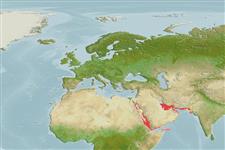Environment: milieu / climate zone / depth range / distribution range
Ecology
Marine; benthopelagic; depth range 0 - 100 m (Ref. 114953). Subtropical; 28°N - 12°N, 33°E - 68°E (Ref. 114953)
Western Indian Ocean: Red Sea, Gulf of Oman, and probably Gulf of Aden and other areas of NE Arabian Sea. Reports from Mediterranean Sea and elsewhere in Indo-Pacific need confirmation.
Length at first maturity / Size / Weight / Age
Maturity: Lm ?, range 83 - ? cm
Max length : 120 cm WD male/unsexed; (Ref. 8630)
A benthic species often found in very shallow water near the coast and offshore on the continental shelf (Ref. 9909, Ref.114953). Feed on small mollusks and bony fishes (Ref. 12951) and crustaceans (Ref. 127960). Ovoviviparous (Ref. 50449). Produces up to 10 pups a litter, mainly from May to October (in the Red Sea region) (Ref. 114953). Size at least 171 cm TL. Males matures at ca. 83 cm TL, birth size at ca. 29 cm TL (Ref.114953). Utilized where it occurs but information lacking (Ref. 9909). A target species and utilised bycatch mainly in artisanal fisheries (Ref. 127960).
Life cycle and mating behavior
Maturity | Reproduction | Spawning | Eggs | Fecundity | Larvae
Exhibit ovoviparity (aplacental viviparity), with embryos feeding initially on yolk, then receiving additional nourishment from the mother by indirect absorption of uterine fluid enriched with mucus, fat or protein through specialised structures (Ref. 50449).
Compagno, L.J.V., 1999. Checklist of living elasmobranchs. p. 471-498. In W.C. Hamlett (ed.) Sharks, skates, and rays: the biology of elasmobranch fishes. Johns Hopkins University Press, Maryland. (Ref. 35766)
IUCN Red List Status (Ref. 130435: Version 2025-1)
Threat to humans
Harmless
Human uses
Fisheries: bycatch
Tools
Special reports
Download XML
Internet sources
